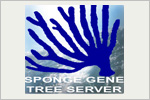Early family ties
No sponge in the human family tree
02.04.2009
LMU Press Release
Since the days of Charles Darwin, researchers are interested in reconstructing the “Tree of Life”, and in understanding the development of animal and plant species during their evolutionary history. In the case of vertebrates, this research has already come quite a long way. But there is still much debate about the relationships between the animal groups that made their apparation very early in evolutionary history, probably in the late Precambrian, some 650–540 million years ago. An international research group led by LMU Munich Geobiology Professor Gert Wörheide and colleagues from France and Canada has now managed to explain the relationships between some of these very early animal groups with a high degree of confidence. In the most comprehensive study of its kind, the researchers show that all sponges descended from a unique sponge ancestor, who in turn was not the ancestor of all other animals. That means that humans did not descend from a sponge – like organism either, as some scientists have put forward. Moreover, the results also suggest that the nervous system only evolved once in animal history.
The most ancient animal groups (phyla) include the Porifera (sponges), Placozoa, Cnidaria, and Ctenophora (comb jellies). The sponges are extremely simply built, and have no organs. The placozoans also have a very simple structure. They have a flat, disk-shaped body, and no organs either. Comb jellies, the ctenophores, are life forms that resemble jellyfish. The true jellyfish, however, are part of the cnidarians, a phylum that also includes corals and sea anemones. The exact relationships among these early animal groups are still controversial, as different research groups have often obtained conflicting results. In particular, results from morphological studies, which look for structural similarities between different organisms, frequently contradict the results from molecular biological studies. The latter explore the functions of genes, and deduce phylogenetic relationships from gene sequences.
Aiming to resolve these controversies, a group of international scientists led by Hervé Philippe (Université de Montréal, Canada), Gert Wörheide (LMU Munich, Germany) and Michael Manuel (University of Paris, France) performed the most comprehensive study to date and investigated 128 genes from a total of 55 species – including nine poriferans, eight cnidarians, three ctenophores and the single known species of placozoans. Their analyses were based on a relatively new approach called phylogenomics, which determines the evolutionary relationships of life forms by comparing large datasets of gene sequences. Together with biochemists, evolutionary and computational biologists from Germany, France and Canada, the team analyzed more than 30,000 amino acid positions. Using computer analyses, the researchers then estimated a phylogenetic tree that displays how related the studied animals are.
One of the most significant outcomes of this study is new evidence that all species of sponges are descendants of a single ancestor. On the other hand, Bilateria, which include worms, mollusks, insects, and vertebrates, did not descend directly from this "spongy" ancestor. “If the ancestral animal would have had a sponge-like organization or body, as some earlier molecular studies repeatedly claimed, then we would all be descendents of such sponge-like organisms,” explains Wörheide. “This proposition generated a lot of attention in the past. But our results clearly disagree with it.” The analyses also revealed that ctenophores and cnidarians most likely belong to a common group. “This group, the "coelenterates", is most closely related to the bilaterians," explains Wörheide. “Our results support, after much controversy, a hypothesis that was already formulated back in 1848.”
The investigation also provides new insights into the development of individual organ systems. “Both coelenterates and bilaterians already have nerve cells. Their new corroborated close relationship also suggests that the nervous system developed only once in animal history,” Wörheide states. And yet, another recent and less comprehensive study concerning the non-bilaterians proposed the unorthodox hypothesis that the comb jellies had already diverged from all other species even before the sponges. “Since the comb jellies already have nerve and muscle cells, this would suggest that these features developed several times independently in animal history, or that they were lost in sponges and placozoans,” explains the LMU researcher.
This new study, which compared more evolutionarily ancient life forms than ever before, presents a stimulating framework for future studies. “Our results can now be used to explore how certain key features evolved among animals,” says Wörheide. There is evidence, for example, that part of the genetic toolkit responsible for building the nervous system in other animals was already present in sponges. Similarly, eye-like sensory organs can already be detected in box jellyfish. “One of the goals of future studies will now be to find out how and when the genetic toolkit for the nervous system, muscles and sensory organs evolved in animal history,” Wörheide concludes. (ca/suwe)
The project was funded by the Deutsche Forschungsgemeinschaft (DFG) through the Priority Program 1174 “Deep Metazoan Phylogeny” (www.deep-phylogeny.org).
Publication
“Phylogenomics revives traditional views on deep animal relationships”;
Hervé, Philippe Romain Derelle, Philippe Lopez, Kerstin Pick, Carole Borchiellini, Nicole Boury-Esnault, Jean Vacalet, Emmanuelle Renard, Evelyn Houliston, Eric Quéinnec, Corinne Da Silva, Patrick Wincker, Hervé Le Guyader, Sally Leys, Daniel J. Jackson, Fabian Schreiber, Dirk Erpenbeck, Burkhard Morgenstern, Gert Wörheide und Michaël Manuel;
Current Biology Online
2 April 2009;
DOI: doi:10.1016/j.cub.2009.02.052
Contact
Prof. Dr. Gert Wörheide
Department of Earth and Environmental Sciences and GeoBioCenter
Division of Paleontology, LMU Munich
Tel.: +49-(0)89 / 2180 6718
Fax: +49-(0)89 / 2180 6601
E-Mail
Website: http://www.mol-palaeo.de





